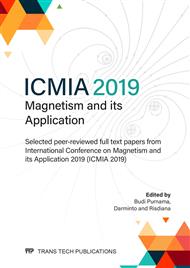[1]
L.V. Panina, K. Mohri, Magneto-impedance in multilayer films, Sensors and Actuators A: Physical., Vol. 81 (2000) 71-77.
DOI: 10.1016/s0924-4247(99)00089-8
Google Scholar
[2]
G.S. Donald, S. Gerhard, P. Fabrice, J. Brice, K. Tanay, B. Shekhar, Review of On-Chip Inductor Structures with Magnetic Field, IEEE Transactions on Magnetics., Vol. 45 (2009) 4760-4766.
Google Scholar
[3]
K. Mohri, T. Kohsawa, K. Kawashima, H. Yoshida, L. Panina, Magneto-inductive effect (MI effect) in amorphous wires, IEEE Transactions on Magnetics., Vol (28) 3150-3152.
DOI: 10.1109/20.179741
Google Scholar
[4]
Y. Honkura, Development of amorphous wire type MI sensors for automobile use, Journal of Magnetism and Magnetic Materials., Vol 249 (2002) 375-381.
DOI: 10.1016/s0304-8853(02)00561-9
Google Scholar
[5]
J. Llandro, J. J. Palfreyman, A. Lonescu, C. H.W. Barnes, C, Magnetic biosensor technologies for medical applications: a review. Medical and Biological Engineering and Computing, Vol. 48 (2010) 977-998.
DOI: 10.1007/s11517-010-0649-3
Google Scholar
[6]
K. Fodil, M. Denoual, C. Dolabdjian, A. Treizebre, V. Senez, In-flow detection of ultra-small magnetic particles by an integrated giant magnetic impedance sensor, Applied Physics Letters., Vol. 108 (2016) 173701.
DOI: 10.1063/1.4948286
Google Scholar
[7]
N.A. Buznikov, A. P. Safronov, I. Orue, E. V. Golubeva, V. N. Lepalovskij, A. A. Chlenova, G.V. Kurlyandskaya, Modelling of magneto-impedance response of thin film sensitive element in the presence of ferrogel : Next step toward development of biosensor for in-tissue embedded magnetic nanoparticles detection, Biosensors and Bioelectronics., Vol. 117 (2018) 366-372.
DOI: 10.1016/j.bios.2018.06.032
Google Scholar
[8]
A. Asfour, J. Nabias, P. S. Traore, J. P. Yonnet, Practical Use of the GMI Effect to Make a Current Sensor, IEEE Transactions on Magnetics., Vol. 55 (2019).
DOI: 10.1109/tmag.2018.2872622
Google Scholar
[9]
T. Wang, C. Lei, J. Lei, Z. Yang, Y. Zhou, Preparation of meander thin-film microsensor and investigation the influence of structural parameters on the giant magnetoimpendance effect, Applied Physiscs A., Vol. 109 (2012) 205-211.
DOI: 10.1007/s00339-012-7034-z
Google Scholar
[10]
W. E. Prastyo, F. Maulana, N. Nuryani, B. Purnama, Magneto-impedance in Multilayered [NiFe80/Cu20]4 with modification of the line-length pattern on Cu printed circuit board. Journal of Physics: Conference Series 909 (2017) 012030.
DOI: 10.1088/1742-6596/909/1/012030
Google Scholar
[11]
Z. Zhong, H. Zhang, Y. Jing, X. Tang, S. Liu, Magnetic microstructure and magneto-impedance effect in NiFe/FeA1N multilayers films, Sensors and Actuators A: Physical., Vol. 141 (2008) 29 – 33.
DOI: 10.1016/j.sna.2007.07.009
Google Scholar
[12]
M. Amiruddin, U. Utari, P. Budi, Fenomena Magneto-impedansi untuk Frekuensi Rendah pada Multilayer [Ni80Fe20/Cu]N Hasil Elektro-deposisi, Jurnal Fisika dan Aplikasinya., Vol. 10 (2014) 95-98.
DOI: 10.12962/j24604682.v10i2.813
Google Scholar
[13]
J. J. Beato-Lopez, J. I. Perez-Landazabal, C. Gomez Polo, Magnetic nanoparticle detection method employing non-linear magneto-impedance effects, Journal of Applied Physics., Vol. 121 (2017) 163901-5.
DOI: 10.1063/1.4981536
Google Scholar
[14]
Y. H. Ding, K. Xue, W. Y. Wang, & X. Ma, Influence of Aspect Ratio on Giant Magneto-impedance Effect for Fe67Co18Si11B4 Amorphous Ribbons. Acta Metallurgica Sinica (English Letters), Vol. 30 No.12(2017) 1236–1242.
DOI: 10.1007/s40195-017-0617-0
Google Scholar
[15]
D. Jagannath, R. Alejandro, M. Pritish, S. Hariharan, P. H. Manh, Magneto-impedance With Enhanced Sensitivity for Highly Sensitive Detection of Nanomag-D Beads, IEEE Transactions on Magnetics, Vol 49 No. 7(2013) 4060-4063.
DOI: 10.1109/tmag.2012.2235414
Google Scholar
[16]
H. Kikuchi & C. Sumida, Incident Power Influence on Magneto-impedance Element With Domain-Wall Resonance. IEEE Transactions on Magnetics, Vol. 54 No. 11(2018) 1–5.
DOI: 10.1109/tmag.2018.2854863
Google Scholar
[17]
M. H. Phan & H. X. Peng, Giant magneto-impedance materials: Fundamentals and applications. Progress in Materials Science, Vol. 53 No. 2 (2008) 323–420.
DOI: 10.1016/j.pmatsci.2007.05.003
Google Scholar


